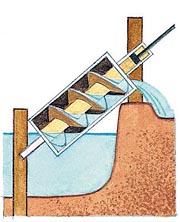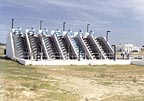
In ancient times, not a lot of thought went into the task of transporting water. You'd go down to the river or the well, fill an earthen jar or animal skin with the water and carry it off to wherever you wanted it. The brain trust available at the time offered but two primary guidance tips for end users: The stuff runs downhill and it's a whole bunch easier if something else does the carrying - a donkey or a slave, for instance.
The first real technological improvement in the realm of water conveyance was the shadoof. This was a seesaw-like device that had a large bucket at one end and a counterweight on the other. One person could operate it, and it could lift enough water in a day to irrigate an acre or so. It still was a backbreaking endeavor but capacity was indeed increased. And that was it for the next few hundred years until 230 B.C. when Archimedes, one of the three greatest mathematicians of all time (Isaac Newton and Carl Friedrich being the other two), took time out from developing integral calculus (remember that class?) to help a friend whose boat was taking on water. That's when he came up the Archimedes water screw, the first device that featured the characteristics of a pump. The implement was based on the study of the spiral, for which Archimedes wrote a treatise titled, “On Spirals,” in 225 B.C.

How It Works
The reason this simple mechanical device is called a screw pump is because it consists of a cylinder inside of which a continuous screw, extending the length of the cylinder, forms a spiral chamber. By placing the lower end in water and revolving the screw, water is raised to the top, where it is attached to a pipe system or positioned above the area where the water is to be deposited.
The construction of this ingenious device is, indeed, relatively simple. One to three helical vanes are fastened to a wooden core and then the exterior housing is applied around the outer edges of the vanes. Iron rods projecting from either end of the core allow the whole thing to be rotated. The water screw acts as a displacement pump, lifting the water in the spiral path created by the rotating helical vanes. The screw-shaped spindle rotates centrally within the casing bore, creating the necessary separation between suction and discharge actions.
The pump's efficiency is dependent upon the number of vanes, the angle of the vanes within the pipe and the angle of the screw in the water. The rigid screw usually has an angle of about 30 degrees and the lift obtained is approximately half the length of the screw.
The first use of the water screw is said to have been by Archimedes himself to pump out the water that had collected in the bilge of a big ship owned by his friend Hieron II of Syracuse. It also was used as a de-watering device for mines, but its most important application was for irrigating fields along the Nile River.
About the Inventor
Archimedes was, perhaps, the original one-armed paperhanger; he had so much going on that he couldn't even keep up with himself. He maintained an extremely wide range of interests and pursuits - had he concentrated on any one of them, he'd have been the greatest ever in that particular discipline. Besides his legendary work in mathematics, he made a great many contributions to astronomy, hydrostatics, engineering, optics and geometry.
It's rather ironic that the man is most remembered for the things of which he cared the least. He was so interested in developing his many theorems that their actual real-world applications were of little interest to him. Once he figured out something, he was done and moved on to what he considered bigger fish. He worked tirelessly to develop his theories on spirals but the applications were essentially secondary because they kept him from pursuing other academic endeavors. The screw pump he invented based on his spiral work could be considered a favor performed while he'd rather have been doing something else.
However, history has passed down more stories about his practical inventions than his groundbreaking mathematical work. For starters, he was way ahead of his time; people then didn't possess the gray matter necessary to keep up with his theories. Much of his work went ignored or forgotten for hundreds of years before the world's next great thinkers caught up with what he already had done. Nobody could follow his spiral work all the way through, but everybody thought it was great how he could make the water move. They couldn't keep up with his work on mechanics and compound pulleys, but when he made catapults and giant contraptions to destroy the ships of the Roman enemy, people appreciated that. His most renowned invention to ward off the attacking Romans was a series of giant lenses that magnified the sun's rays and set the Roman ships ablaze. In his mind, however, these practical applications only delayed the start of work on his next theoretical project.
As has been the case with many of the great minds in history, Archimedes was a tad bit eccentric and lived in his own little world - a trait that contributed in no small measure to his ultimate demise. When the Romans finally did seize Syracuse in 212 B.C., a Roman soldier came upon Archimedes, who was working on one of his mathematical theories by placing stones in certain positions on the ground. The soldier confronted Archimedes, who was so caught up in his work, he chose to ignore the soldier. When the soldier kicked his carefully placed stones, Archimedes went into a tirade featuring language a shade too colorful for the soldier's liking. As patience was not a particular strong suit of the typical Roman soldier of that time, this one spent more time cleaning off his sword than he did running it through the 75-year-old Archimedes.

Still in Use
In its original form, the screw pump still is used in many parts of the world to raise irrigation water from the banks of rivers. Modern versions of the screw that are in industrial use today are basically unchanged from the original with two exceptions - the donkey or slave has been replaced by a motor, and the screw rotates inside the cylinder instead of the entire cylinder being rotated (this allows the top to be removed to facilitate maintenance). The modern Archimedes pump often is used in situations wherein the water being moved contains large debris and the discharge is large and the height minimal - making it a good choice for pumping wastewater and storm water runoff. Other modern, non-water applications include oil pumping and, on a smaller scale, blood circulation support during surgical operations. It also can be applied for handling light, loose materials, such as grain, sand, ashes and the like.
Next month, we'll look at the force pump, a much more complex apparatus, especially considering the time of its invention.



Report Abusive Comment